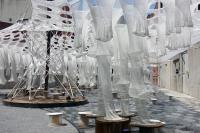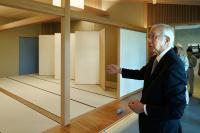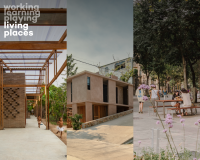Karmeliterhof
Graz, Österreich
The project, an office building of the Landesimmobiliengesellschaft (provincial real estate department), is situated in the heart of Graz’s old town.
The project goals were to adapt and renovate the building and to add annexes that met the following objectives:
1. Upgrade the facades both architecturally and thermally
2. Modernize and adapt the existing buildings
- improve workplace quality
- offer complete accessibility
- adapt to new fire protection OIB-regulations,
3. Enhance the building components connecting the buildings to form a closed, functioning complex.
The existing building complex consisted of three buildings of very different construction quality and from different time periods:
- Karmeliterplatz 2, an office building from the late 1960s, which was seen as a foreign element after the new design of the square in 2005
- Karmeliterplatz 1, a landmarked building from the early baroque period
- Paulustorgasse 4, a building from the late baroque period, which was significantly altered in the 1950s (i.e. new roof, one wing and annexes in the courtyard).
The following goals guided the design of the new buildings and the modifications made to the existing structures:
- Uncover and expose the valuable old building structure
- Develop a new design to replace or incorporate the modifications from the 50s and 60s, which would link with the new construction to restore the valuable closed layout of the earlier design.
The “dynamic façade” / Karmeliterplatz 2 Renovation
The renovation was based on the Graz tradition, which its characteristic three-dimensional, “dynamic facades” (created with a special plastering technique) and typical “Grazerstock” windows (re-interpreted with contemporary methods):
The ceiling-high window casements (mounted in front of the façade at a slight angle towards the plane of the façade) face the square and therefore reflect by turn the activities in the square, the surrounding building fronts or the sky in different refraction.
Functionally speaking, the facade is a climate façade, a double-skin façade with a fixed glass front made of solar control glass and a circumferential frame that features ventilation openings at the bottom and on the sides. Sliding doors are mounted towards the interior and form the actual spatial enclosure.
Opening the sliding door wings creates a natural air exchange. This natural exchange is supported by the mechanical night ventilation of the rooms and leads to a very effective room cooling. Experience has shown that this prevents overheating in the summer and that the working climate remains pleasant during the day. Moreover, the double-skin façade functions as a winter garden and is furnished with plants.
The new roof landscape
The “bent” roof of the annex is folded over the renovated roof structures and new building components around the courtyard. Thus, the historic tiled roofs are completely preserved and contrast with the new roofing.
The previous alterations and additions were removed from the valuable Paulustorgasse 4 and Karmeliterplatz 1 buildings, thereby exposing the historical structure and restoring the original room layout to the greatest possible extent.
- Architekten
- LOVE architecture and urbanism
- Standort
- 8010 Graz, Österreich
- Jahr
- 2011













